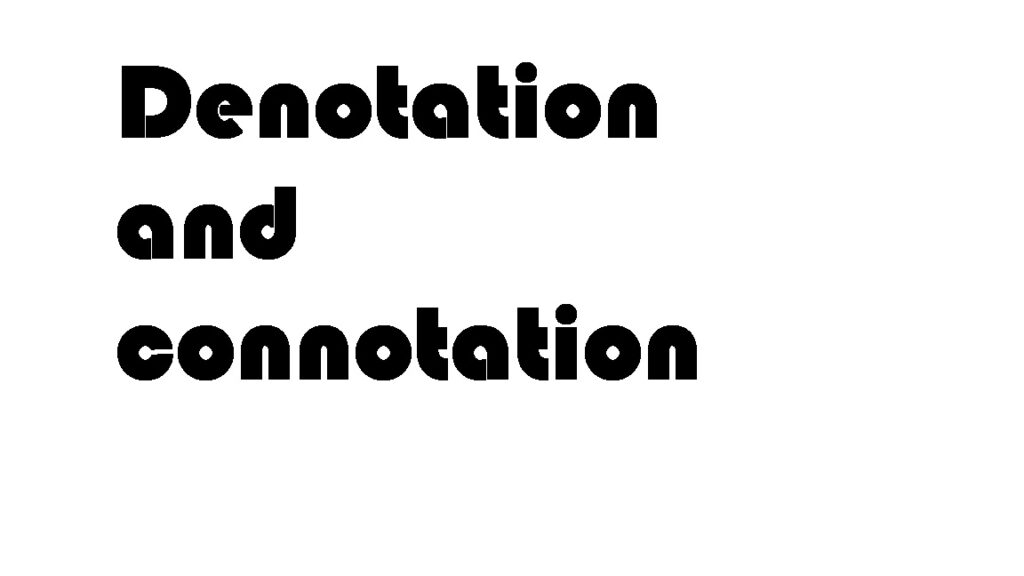Denotation and connotation
Denotation and connotation are two important aspects of meaning in language, particularly in the field of semantics.
Denotation refers to the literal or dictionary definition of a word, essentially its explicit or direct meaning. It is the objective and universally accepted meaning of a word, independent of any personal or subjective interpretations. For example, the denotation of the word “dog” is a domesticated carnivorous mammal that typically has a long snout, an acute sense of smell, and a barking or howling voice.
Connotation, on the other hand, refers to the subjective and emotional associations or implications that are attached to a word beyond its literal meaning. It involves the cultural, social, and personal interpretations or values associated with a word. Connotations can vary among individuals or within different contexts. For example, the word “dog” may have positive connotations for someone who loves animals and sees them as loyal companions, while it may have negative connotations for someone who has had a traumatic experience with dogs.
Connotations can be influenced by various factors, including cultural background, personal experiences, societal norms, and even the use of language in different contexts. They can be subtle and nuanced, adding layers of meaning and depth to words beyond their denotative definitions.
Understanding the denotation and connotation of words is crucial in effective communication, as it helps convey the intended meaning and allows for a more nuanced understanding of language.
Denotation and connotation across cultures
Denotation is often regarded as the literal or primary meaning of a word, while connotation refers to the secondary or associated meanings.
Denotative meanings are generally objective and can be found in dictionaries, whereas connotations are subjective and can vary from person to person or across different contexts.
Connotations can be influenced by cultural factors. Words may carry different connotations in different cultures or societies. For example, the color white may connote purity and innocence in some cultures, while it may symbolize mourning or death in others.
Words can have both positive and negative connotations. The connotation associated with a word can shape how it is perceived and received by others. For instance, the word “snake” can connote deception and treachery, carrying a negative connotation, while the word “home” can connote warmth and security, carrying a positive connotation.
Connotations can also be influenced by personal experiences and individual associations. A word may evoke different emotions or thoughts in different individuals based on their unique backgrounds and experiences.
Connotations can be created or altered through the use of figurative language, such as metaphors, similes, and symbolism. These devices can evoke specific emotions or associations, adding depth and richness to language.
Writers and speakers often use connotation intentionally to convey their intended meaning or to create a certain tone or atmosphere in their communication. By carefully selecting words with specific connotations, they can influence how their message is received by the audience.
It’s important to note that connotations are not inherently good or bad. They simply reflect the subjective associations people have with words. However, some words may have widely accepted negative or positive connotations due to historical, social, or cultural reasons.
Understanding denotation and connotation allows us to navigate the complexities of language and communicate more effectively. It helps us appreciate the power of words and the nuances they carry beyond their literal definitions.
Denotation and connotation objectivity
Denotation is often associated with the objective or explicit meaning of a word, while connotation deals with the subjective or implicit meaning.
Denotation is concerned with the basic, factual definition of a word, whereas connotation involves the emotional, cultural, and personal associations linked to a word.
Denotation is more stable and consistent across different contexts and individuals, while connotation can vary based on personal experiences, cultural backgrounds, and societal influences.
Denotative meanings are typically shared and understood by a wide range of people, while connotations may be more specific to certain groups or individuals.
Connotations can evolve and change over time. The meaning and associations of words can shift as language evolves and societal attitudes shift. For example, certain terms that were once considered derogatory may acquire more neutral or positive connotations over time.
Words can have both positive and negative connotations, or they can be neutral. These connotations are often shaped by cultural norms, historical contexts, and individual perspectives.
Connotations can be influenced by factors such as tone of voice, body language, and the overall context in which words are used. The same word can have different connotations depending on how it is delivered or the context in which it is used.
Connotation plays a significant role in literature, advertising, and persuasive communication. Writers and advertisers often choose words with specific connotations to evoke emotions, create a desired impression, or influence the audience’s perception.
It’s important to consider both denotation and connotation when interpreting or analyzing language. While denotation provides the literal meaning, connotation adds layers of depth and complexity to the overall meaning and impact of words.
Developing an awareness of connotation can enhance our communication skills by allowing us to choose words more deliberately and effectively convey our intended messages. It also helps us interpret language more accurately by recognizing the subtle implications and associations that words carry.
Understanding denotation and connotation provides us with a deeper understanding of language and its nuances. It enables us to engage in more nuanced and effective communication, both as speakers and listeners.
Denotation and connotation interpretation
Denotation represents the literal, direct, and explicit meaning of a word or phrase. It refers to the dictionary definition or the commonly accepted understanding of a word. Denotative meanings are often shared across different individuals and cultures. For example, the denotation of the word “apple” is a round fruit with red, green, or yellow skin and a crisp texture.
Connotation, on the other hand, involves the subjective, emotional, and cultural associations that are associated with a word. It goes beyond the literal definition and incorporates the implied meanings, attitudes, and feelings evoked by a word. Connotations can vary based on personal experiences, cultural backgrounds, and social contexts.
Connotation can be influenced by various factors, including historical events, cultural symbols, societal norms, and personal biases. For instance, the word “freedom” may have positive connotations, representing liberation and autonomy, while the word “control” may have negative connotations, suggesting restriction and oppression.
Words can have both positive and negative connotations, or they can be neutral, lacking any strong emotional associations. The connotations of a word can impact how it is perceived, received, and interpreted by others. They can shape the overall tone, mood, and message of a communication.
Connotations can be subtle and nuanced, requiring an understanding of cultural references, figurative language, and symbolism. For example, the word “home” may connote warmth, comfort, and a sense of belonging, evoking feelings of security and stability.
The use of connotation can be intentional or unintentional. Skilled writers and speakers often employ connotative language to evoke specific emotions, create vivid imagery, or persuade their audience. Advertisers, for instance, use connotations to associate their products or services with positive emotions and desirable qualities.
It’s important to consider both denotation and connotation when interpreting or analyzing language. While denotation provides the basic meaning, connotation adds layers of depth and subjective interpretation. By being aware of the connotations associated with words, we can better understand the intended messages and the impact of our own words.
The study of denotation and connotation falls within the field of semantics, which explores how words and symbols convey meaning. Understanding these aspects of meaning enhances our language skills, improves our ability to communicate effectively, and enables us to navigate the subtleties of language and culture.
By recognizing and appreciating the interplay between denotation and connotation, we can gain a deeper understanding of the power of language and its impact on communication and perception.
Denotation and connotation misinterpretation
Here’s an example that demonstrates how connotation can affect the interpretation of a message:
Let’s say someone is describing a person as “persistent” and another person as “stubborn.” While the denotation of both words implies a certain level of determination or refusal to give up, the connotations associated with these words can lead to different interpretations:
Positive Connotation: If the word “persistent” carries a positive connotation, it may be seen as a desirable trait indicating perseverance, dedication, and a strong work ethic. In this case, the person described as “persistent” is likely viewed in a favorable light.
Negative Connotation: Conversely, if the word “stubborn” carries a negative connotation, it may be perceived as an undesirable trait indicating inflexibility, obstinacy, and an unwillingness to consider alternative viewpoints. The person labeled as “stubborn” may be seen in a less favorable or even negative light.
In this example, although the denotative meanings of “persistent” and “stubborn” overlap to some extent, the connotations associated with these words influence how the individuals’ traits are perceived and evaluated. The choice of one word over the other can shape the overall tone and impression of the description.
This demonstrates how connotation adds layers of meaning and subjective interpretation to language, influencing the way we understand and respond to messages. It highlights the importance of considering both denotation and connotation when analyzing and interpreting communication.
Find us on Facebook
Practice Digital SAT

